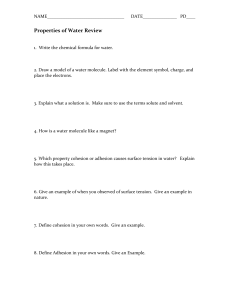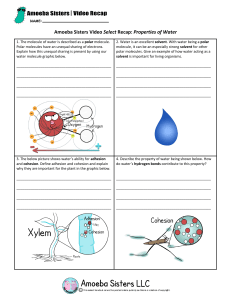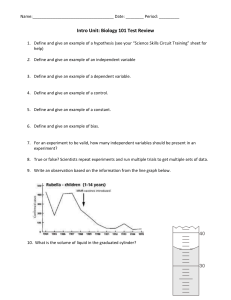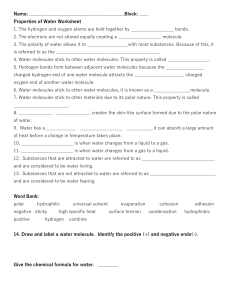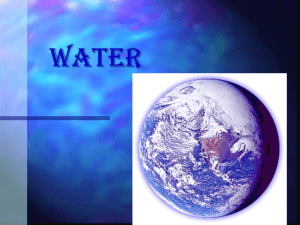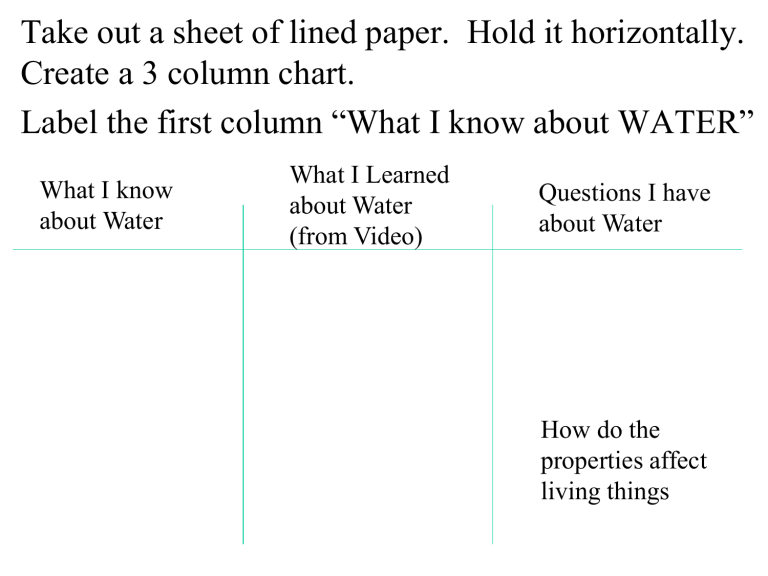
Take out a sheet of lined paper. Hold it horizontally. Create a 3 column chart. Label the first column “What I know about WATER” What I know about Water What I Learned about Water (from Video) Questions I have about Water How do the properties affect living things • http://www.cleanvideosearch.com/media/ac tion/yt/watch?v=HVT3Y3_gHGg&feature= relmfu Properties of Water Water Molecule • 1 oxygen atom, 2 hydrogen atoms • The 3 atoms are held together by polar covalent bonds • Electrons are not shared equally, they are closer to the oxygen • Molecule has a bent shape (looks like Mickey head) • 7 Properties of water 1. Polarity • Polar molecule – a molecule with positive and negative charged regions – In water, electrons shared unequally • Oxygen is more electronegative, giving it a partial - charge • Hydrogen atoms get a partial + charge • This causes the – end of one water molecule to be attracted to the + end of a different water molecule • A hydrogen bond forms between the + oxygen and – hydrogen on the different molecules – Each water molecule can form hydrogen bonds with up to four neighbors. – Hydrogen bonds are very weak, they break and reform easily – But!-They are the basis for the other properties of water Fig. 3.1 Copyright © 2002 Pearson Education, Inc., publishing as Benjamin Cummings 2. Capillary Action • Capillary Action – the ability water has to flow upward against the force of gravity, due to cohesion and adhesion • Cohesion (cohesive) – sticking together of two like molecules – 2 water molecules are cohesive due to the hydrogen bonds • Adhesion (adhesive) – sticking together of two unlike molecules – Ex: A water molecule being attracted to a sugar molecule (Like making Kool-aid) DEMO! • Take a dry penny. • Slowly add drops of water to the penny. • How many drops can you add? COHESION!! How does water get to the top of plants? Cohesion & Adhesion • Cohesion among water molecules causes them to pull one another upward against gravity • Adhesion contributes too, as water adheres to the wall of the vessels, so it can travel upward DEMO! • What allowed the coloring in the water to get to the top of the celery stalk? Brainpop “Water” http://www.brainpop.com/science/earthsystem /water/ 3. Surface Tension • Surface tension- a measure of the force necessary to stretch or break the surface of a liquid – Hydrogen bonds between water molecules at surface of water resist breaking creating an “invisible film” – This allows some insects to walk/run on water DEMO! • Take a dry paper clip and carefully try to lay it on the surface of the water SURFACE TENSION 4. Heat Capacity • Specific Heat - amount of heat that must be absorbed or lost before it actually changes temperature – Water has a high specific heat – Water can absorb or release large amounts of heat with only a slight change in its own temperature. • Ex: Water takes a long time to boil Practice 1. Which of the following describes 2. Which property of a hydrogen bond? water provides the a. the bond between two hydrogen cooling effect of atoms within a molecule of water sweating? b. the bond between hydrogen in one water molecule and another a. cohesiveness hydrogen in a different water b. surface tension molecule c. high heat of c. the bond between hydrogen and vaporization oxygen within a molecule of d. high heat capacity water d. the bond between hydrogen in one water molecule and oxygen in a different water molecule Heat Capacity • Because of this water stabilizes air temperatures • Cool water absorbs heat from warm air – Ex: Coastal cities have mild weather Practice 1. Which of the following is an example of heat capacity/specific heat? a. ice floats in water b. sweating lowers body temperature. c. sugar disappears when added to water. d. it takes several weeks of warm temperatures to raise lake water several degrees. 2. Which property of water helps to explain that it takes a bit of time for a pot of water to boil? a. adhesion b. density c. specific heat d. universal solvent 5. Heat of Vaporization • Heat of Vaporization- The cooling of a surface occurs when the liquid evaporates – Ex: water boils as the steam leaves the water it takes the heat with it, and the water cools – Ex: Your body sweats so the water will absorb your heat then evaporate to cool you. 6. Density • Density- a measure of how compact the atoms or molecules are within a substance or how much mass there is in a given space (volume) – Water compared to other liquids (like syrup) is not very dense. • Water is more dense as a liquid than as a solid • When water freezes and becomes ice, the polarity causes hydrogen bonds to form but there is air in between – Causes expansion – Ice floats in water. • If this didn’t happen all the icebergs would sink- water levels would rise. • Ice floats on top and insulates water below- fish can live. DEMO! • Ice, water, alcohol…. 7. Universal Solvent • Solvent- a liquid that dissolves a particle (solute) • Solute- particle or liquid that gets dissolved in the solvent – Ex: Salt water Water- Solvent, Salt- Solute • Water is a solvent that dissolves most solutes. • If the solute molecules are polar, like water, the positive ends of water are attracted to the negative ends of the solute. • This is also why the solute is even throughout all the water • For each Picture decide which property of water is being used. Practice – Write down the number and answer 1. The hydrogen and oxygen atoms are held together by ___ bonds. 2. The electrons are not shared equally creating a __ molecule. 3. The polarity of water allows it to __most substances. Because of this it is referred to as the __ __. 4. Water molecules stick to other water molecules. This property is called ___. 5. Hydrogen bonds form between adjacent water molecules because the __charged hydrogen end of one water molecule attracts the __ charged oxygen end of another water molecule. 6. Water molecules stick to other materials due to its polar nature. This property is called __. 7. ___ ___ creates the skin-like surface formed due to the polar nature of water. Properties of Water and their Connection to Life on Earth Density Specific heat Density Properties of Water and their Connection to Life on Earth Cohesion Surface Tension Surface Tension Cohesion Adhesion Capillary Action Cohesion Properties of Water and their Connection to Life on Earth Specific heat Insulation Properties of Water and their Connection to Life on Earth Solubility Specific Heat Density Let’s Review! 1. Water molecules move farther apart during when water freezes, causing it to expand. Which of the following is a consequence of this property? a. Only a limited amount of solute can be dissolved in a sample of water. b. Objects with a higher density than water can be observed floating on water. c. The water in lakes, ponds and puddles freezes from top down. d. Water is considered to be a universal solvent. 2. Water makes an upward curved meniscus in a graduated cylinder. What property of water accounts for the attraction of the water to the glass? a. Adhesion b. Cohesion c. Ionic Bonds d. Nonpolar Covalent Bonds Let’s Review! 3. Water is a polar molecule that attracts other polar molecules. Which of the following is a consequence of this property? a. Water is considered to be a universal solvent. b. Water can only dissolve a limited amount of solute. c. When water freezes, the molecules move farther apart. d. The water in lakes, ponds and puddles freezes from top down. 4. Water has a high surface tension. What property of water allows an insect to walk on water? a. Adhesion b. Cohesion c. Ionic Bonds d. Nonpolar Covalent Bonds Let’s Review! 5. When mothballs are added to an Erlenmeyer flask and then sealed, phase equilibrium could occur. Which answer explains the resulting dynamic equilibrium? a. Condensation = Evaporation b. Melting = Solidification c. Evaporation = Precipitation d. Solidification = Sublimation 6. The equilibrium equation below shows ammonium hydroxide (NH4OH) decomposing into ammonium ions (NH4+) and hydroxide (OH-) ions. NH4OH ↔ NH4+ + OHWhen is this system in equilibrium? a. after all the ammonium hydroxide has reacted b. after both forward and reverse reactions have stopped c. once the forward and reverse reactions proceed at the same rate d. once the ammonium ions and the hydroxide ions have completely reacted
